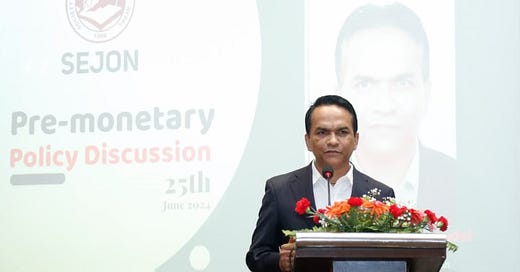Why the NRB alone cannot solve the bad-debt mess
Rotten loans are soaring. So is the realisation monetary policy by itself is a blunt tool
Image via Fiscal Nepal
Bad debts, like bad habits, tend to creep up slowly, and then all at once. The financial sector is now nursing a non-performing loan (NPL) ratio of 5.24%, the highest in recent memory, with delinquencies ballooning by more than NPR 95 billion in the past year alone. That is not a crisis yet, but it is enough to trigger alarm at the Nepal Rastra Bank (NRB), the country’s central bank. Governor Maha Prasad Adhikari’s successor, Biswo Nath Poudel (pictured), has hinted the upcoming monetary policy will focus squarely on cleaning up the mess, particularly in loans to small businesses and farms. But the rot is more troublesome than the NRB dares to admit, and broader than monetary loosening can resolve.
The deterioration is not evenly spread. Seven commercial banks (out of 20) have reported NPL ratios well above 5% with growing piles of seized collateral. Non-banking assets, what lenders collect when loans go sour, have rocketed more than 50% over the last year. That has throttled earnings. Notwithstanding lower base rates compared with few years ago, banks are funnelling less into productive sectors and more into NRB’s short-term monetary instruments. The credit pipes are choked.
Bankers, never known for dramatic flair, are sounding unusually morose. The president of the Nepal Bankers' Association, Santosh Koirala, concedes rural loan recovery rates have fallen below 50%. Rajesh Upadhyay, vice-president of the Confederation of BFIs, calls the NPL surge a “social problem”. That is putting it mildly. The problem is economic, institutional and dangerously cyclical.
The roots of the malaise are familiar. The economic downturn induced by the covid-19 pandemic softened incomes and stunted repayment capacity. Scandals in the cooperative sector, where at least 90 firms absconded with millions of rupees, according to reports, eroded trust and drained liquidity from the fringes. The government’s sluggish spending and a slowdown in real estate further dampened loan demand. Import restrictions meanwhile sapped customs revenue and thinned the fiscal cushion. Into this toxic brew were poured the dregs of past excess: an IMF warning as early as 2019 flagged Nepal’s rapid credit expansion as unsustainable. Regulators snoozed.
The fallout was predictable. Banks scrambled to set aside provisions for mounting bad debts. Capital buffers weakened. So did their capacity to lend. With few safety nets in place, SMEs and farms—the very sectors the government seeks to champion—were the first to suffocate.
Nor is this the country’s first fiasco with delinquency. In the late 1990s NPL ratios at state-owned banks exploded: Rastriya Banijya Bank’s soared from 20% in 1998 to a vertiginous 60% by 2003. Cleaning up the mess required an stonking NPR 3.5 billion in recapitalisation and provisioning, equal to nearly half the national budget and 9% of GDP at the time. Reforms backed by the World Bank and the IMF eventually restored order but at a steep fiscal cost.
Other countries have seen worse, and bounced back stronger. After the 1997 Asian financial crisis, Indonesia, Japan, South Korea and Malaysia each created government-backed asset management companies (AMCs) to absorb bad debts and nurse balance sheets back to health. Indonesia’s IBRA, Japan’s RCC and IRCJ and South Korea’s KAMCO all recovered substantial assets. Malaysia’s Danaharta famously categorised bad loans by size and resolution prospects, recovering nearly 60% of assets. Japan’s approach went even further: recovery rates touched 104%, aided by strict case-by-case resolution and competent execution.
The lesson: cleaning up balance sheets takes more than stern warnings and base-rate cuts. It requires institutional heft. The NRB, for all its monetary tools, cannot fix what is a balance-sheet problem. A well-designed AMC could provide a financial firebreak, giving banks a mechanism to shed toxic assets and focus on fresh lending. But the structure matters. If AMCs merely mop up bad loans without penalising reckless lenders, moral hazard will fester. Banks will lend carelessly, knowing they can offload liabilities at the public’s expense.
To avoid repeating that mistake, any AMC must come with strings attached: punitive pricing; loss-sharing mechanisms; and strict eligibility filters. It must also be firewalled from political interference, a tall order but not impossible. Strong governance, perhaps with international oversight, would help preserve credibility.
The NPL ratio may seem modest by global standards. But in a thinly capitalised banking system with limited fiscal space, even small shocks can cascade. Left unaddressed, bad debts will sap investor confidence and crowd out productive credit. It will also weigh down an already anaemic economy. Worse, they may tip banks into a lending freeze: starving SMEs, the country’s economic backbone, of capital when they need it most.
The central bank is right to worry. But worry alone will not stem the tide. Monetary policy can tighten or loosen credit. It cannot perform surgery on festering assets. For that, Nepal needs institutional scalpel work. An AMC, done right, would be a start. As Japan’s banking reformers discovered, healing a broken system means learning to live with its scars, and making sure they do not reopen. ■



